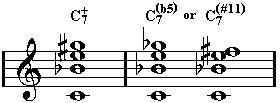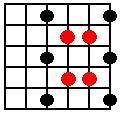The main alteration to a Dominant 7th chord is either a sharp 5 (Augmented) or a flat 5. The flat 5 is usually written as a sharp 11 (11 is the octave of the 4th. Flat 5 = sharp 4 which = sharp 11). Here is the most common voicing:

Let's take the sharp 5 first. If we raise the root an octave we can easily see the E augmented (E+) triad on the top of the chord:

Augmented triads are symmetrical. That means that the notes in the chord are
equidistant from each other so no matter what inversion the chord is in the shape of the chord on the neck is the same as long as you stay on the same set of strings. These three triads are really the same triad. They are inversions of each other. If C is the root position then E+ is the 1st inversion and G#+ is the 2nd inversion.

This means that melodic fragments and phrases that are based on Augmented triads are symmetrical. The Augmented Scale is symmetrical and is also known as the Whole-Tone Scale which is self-explanatory. The Augmented Triad arpeggio patterns you've been working on can now be applied to Dominant Augmented (#5) Chords.
The video clips on this page and all the following ones are limited to the first four keys of the Key Circle (C, F, Bb, Eb) for the sake of brevity. I cannot overemphasize the importance of practicing everything in every key.
Example 1:
This is the easiest and therefore the most commonly used augmented pattern. I'm applying it to a C7+. It can be thought of in that regard as a C+ (based on the root), an E+ (the 3rd of C+), or a G#+ (the 5th of C+), or all of the above. It's based on the Whole-Tone Scale, starts on the 7th of the C7+, and is completely symmetrical:

Clip: Here's the above phrase in the first 4 keys of the Circle:
Example 2:
This one has 3 phrases; the first phrase starts on the root of the triad, the second phrase starts on the 3rd, and the third phrase starts on the 5th.

Clip: First 4 keys of the Circle:
Example 3:
This is another one that goes through the root position, 1st inversion, and 2nd inversion positions for C+. It adds a 2nd to the arpeggio in every position.

Clip: First four keys of the Circle:
II - V - I Examples
(Refer back to the II V I page if you need to)
Example 1:
Here's a II V I progression with an altered V chord. Notice on the first bar the first 4 notes are a straight descending Dmi7 arpeggio. The rest of the bar consists of Dmi7 arpeggio notes with a 4th (G) added. The first 2 notes of the 2nd bar state the 3rd and the root of the G7+. The rest of the bar is an ascending Whole-Tone scale based on the 3rd of the G7+. The first two notes of the 3rd bar are the 5th and the 3rd of the Cmaj7. The quarter-rest emphasizes the 3rd of the chord that was just played. The last short 8th-note phrase is kind of a Be-Bop cliche. It consists of the 4th then the 2nd of C Major. That actually implies a II chord because those 2 notes would be the 3rd and the root of D minor. The last 2 notes are the 3rd and the root of C major.

Clip: First four keys of the Circle:
Example 2:
Over the D-7 is a D Minor Pentatonic. Over the G7+ is 2 Augmented Boxes a whole step apart. Over Cmaj7 I'm thinking E-7 (E minor is the upper extension triad). The D# is a passing tone.

For Dominant flat 5/sharp 11 chords see the sidebar.



